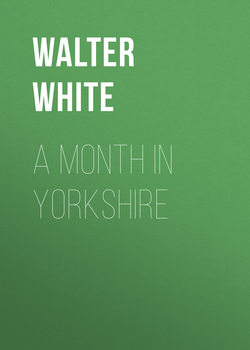Читать книгу A Month in Yorkshire - Walter White - Страница 11
CHAPTER IX
ОглавлениеMen’s and Women’s Wages—The Signal Tower—The passing Fleet—The Lighthouse—The Inland View—Cliff scenery—Outstretching Reefs—Selwick’s Bay—Down to the Beach—Aspect of the Cliffs—The Matron—Lessons in Pools—Caverns—The King and Queen—Arched Promontories—The North Landing—The Herring-Fishers—Pleasure Parties—Robin Lyth’s Hole—Kirk Hole—View across little Denmark—Speeton—End of the Chalk—Walk to Filey.
A fresh, bright morning succeeded the stormy night, and it was but a few hours old when, after a look at the old Danish tower at the west of the village, I walked across the fields to the lighthouse. A woman trudging in the same direction with a hoe on her shoulder said, after I had asked her a few questions, she wished she were a man, for then she would get nine shillings a week and her meat, instead of one shilling a day and feeding herself, as at present. However, ’twas better than nothing. Presently her daughter came up, a buxom maiden, wearing her bonnet in a way which saved her the affliction of shrugs and the trouble of tying. It was front behind: a fashion which leaves no part of the head exposed, shelters the poll, and looks picturesque withal. It prevails, as I afterwards noticed, among the rustic lasses everywhere.
As I passed the old stone tower near the coast-guard station, the signal-man was busy raising and lowering his flag, for a numerous fleet of coasting-vessels was running by to the southward, each telling its name as it came within signal distance. The man sends a daily list of the names to London for publication, whereby coal-merchants and others hear of cargoes on the way, and calculate the time of their arrival. It is a peculiarity of Flamborough Head, an enlivening one, that ships can keep so close in that the men on their decks are distinctly seen, and their voices heard by one standing on the cliff.
The lighthouse, a circular white tower, eighty-two feet in height, stands on the verge of the cliff, displaying inside and out all that admirable order and cleanliness characteristic of British lighthouses. There is no difficulty in obtaining admittance; you sign your name in a book, and are forthwith conducted up to the lantern by the chief or one of his aids. The light is revolving, alternately white and red, and can be seen at a distance of thirty miles. But here, elevated two hundred and fifty feet above the sea, you feel most interested in the prospect. No “shadowy pomp of woods” arrests the eye looking landwards, but a region bleak and bare in aspect rolling away to the distant wolds, the line of uplands which, sweeping round, approaches the coast about Scarborough. The village with its windmill, and the few farms that are in sight, look naked and comfortless: not an inviting territory for an invader given to the picturesque. But seawards, and along the rugged front of the cliffs, grandeur and variety exert their charm. Here the up-piled chalk flings out a bold perpendicular buttress, solid from base to summit; there the jutting mass is isolated by yawning cracks and chasms, and underneath, as we shall presently see, is fretted into fantastic shapes, pierced through and through, or worn into caverns by the headlong billows. In places a broken slope of rocky hummocks and patches of grass, weeds, and gravel descends, more or less abruptly, to the beach, opening a view of the long weed-blackened reefs that, stretching out from the Head, afford a measure of the amazing encroachments of the sea. Northwards, the bluff crowned by Scarborough Castle, backed by higher elevations, closes the view; to the south you have the low, fading coast of Holderness; and all the while brigs, ships, and schooners are sailing past, more than a hundred in sight, some of them so near that you fancy they will hardly escape the lurking points of the dark reef. One small vessel, the keeper told me, had touched the day before, and lay fast and helpless till, the weather being calm, she floated off by the succeeding tide. You can look down into Selwicks Bay, and see men and boys quarrying chalk, and donkeys laden with heavy panniers of the lumps, toiling painfully up the steep winding road which forms the only approach. The farther horn of the little bay is arched and tunnelled, and, taken with the waterfall plunging down in its rear and the imposing features of the points beyond, invites to further exploration.
The residents at the lighthouse enjoy an abundant supply of water from a spring within their enclosure: their garden produces cabbages and potatoes; the neighbours are friendly, and visitors numerous. Hence life is more cheerful to them than to the amphibious hermits who dwell at the Spurn.
While looking for a practicable descending-place, I noticed many tufts of thrift as thick with flowers as in an antiquated garden where the old favourites are still cherished.
“Even here hath Nature lavished hues, and scent,
And melody; born handmaids of the ocean:
The frowning crags, with moss and rock-flowers blent,
Dazzle the eyes with sunlight, while the motion
Of waves, the breezes fragrant from the sea,
